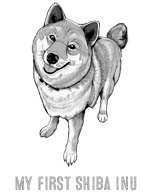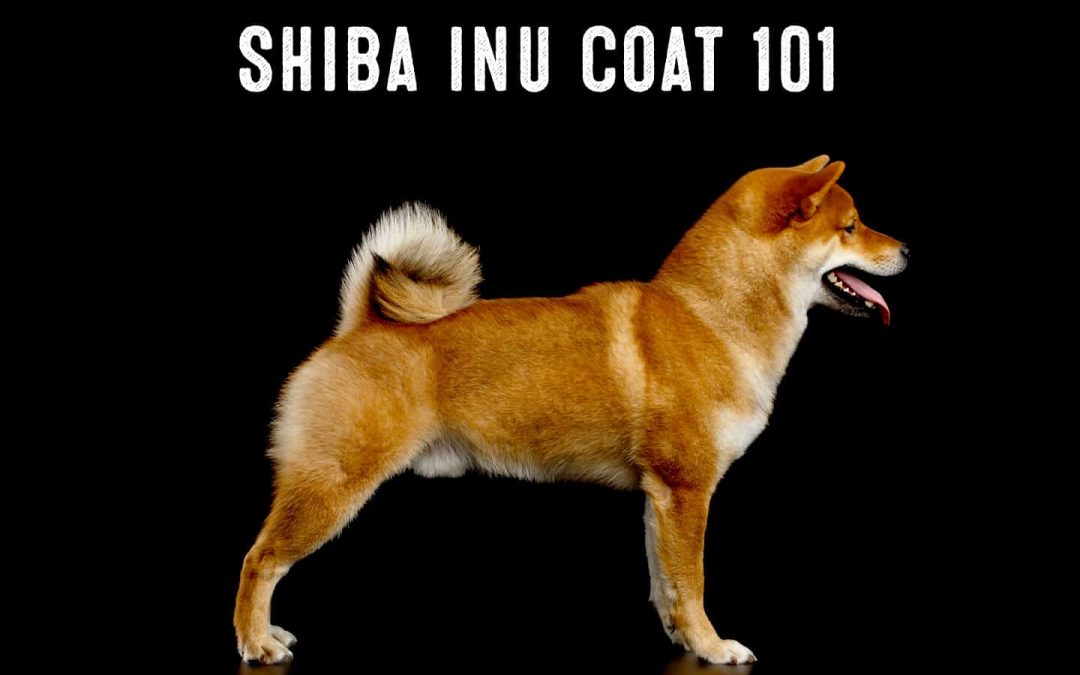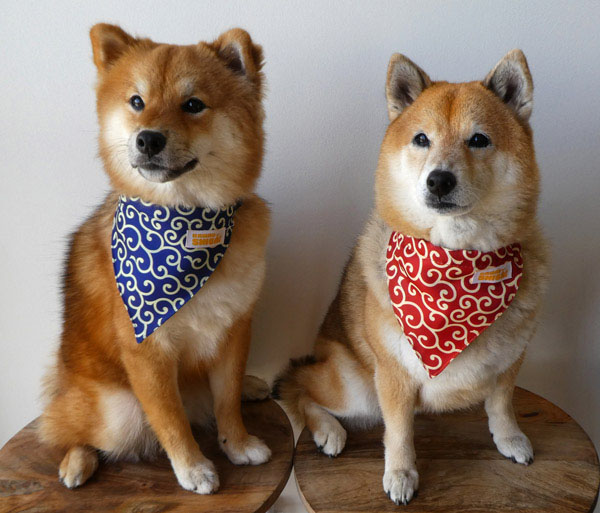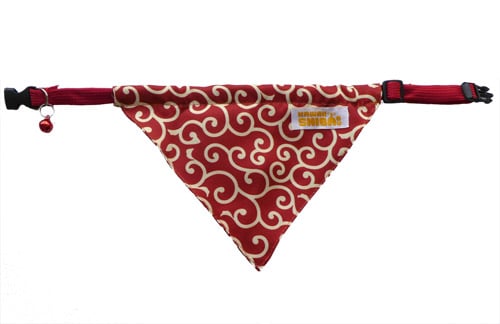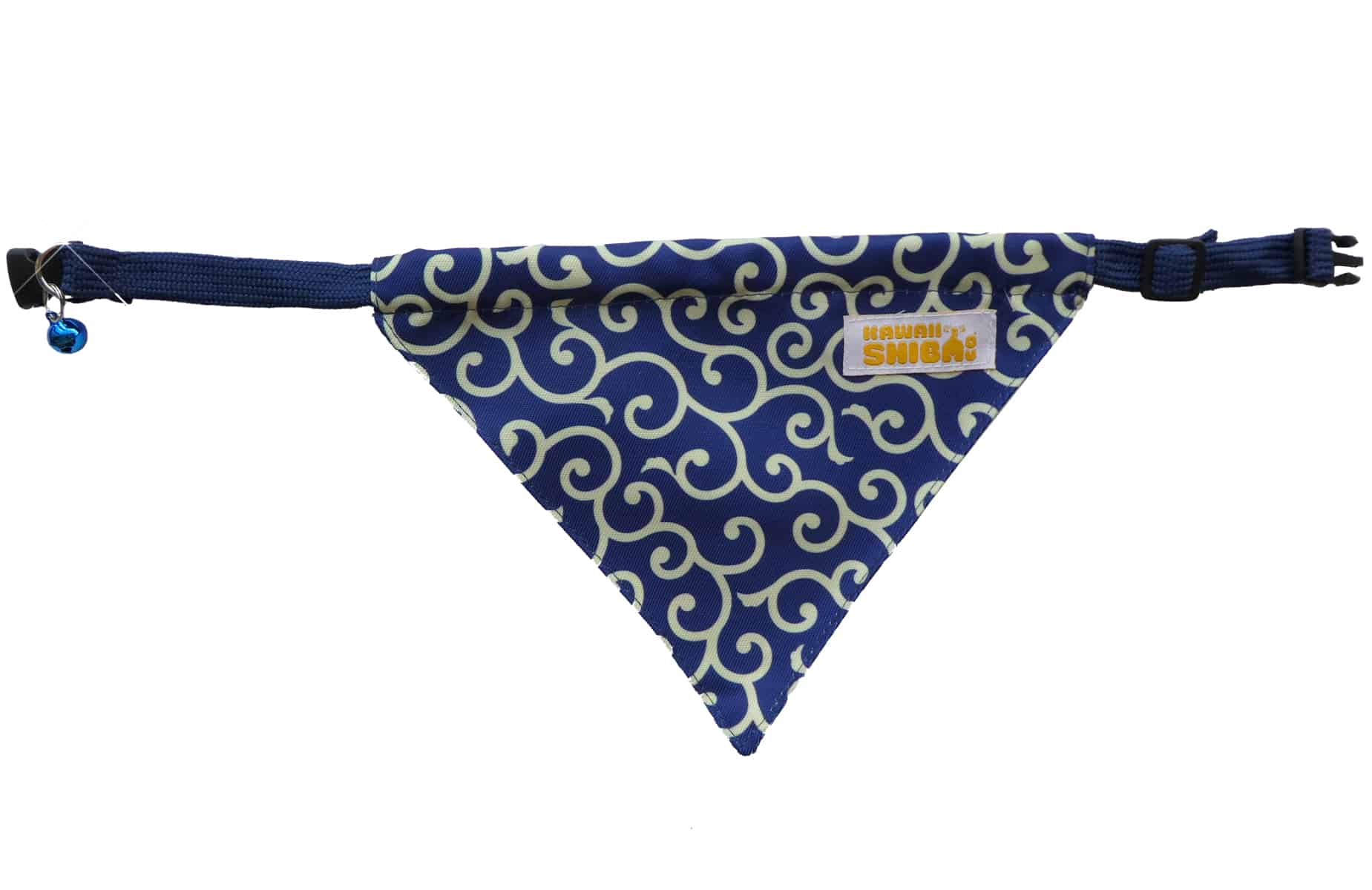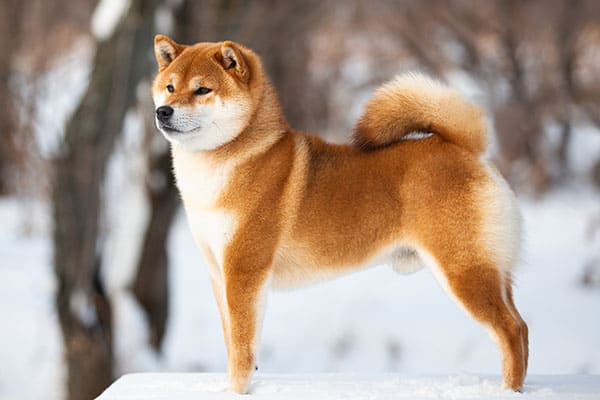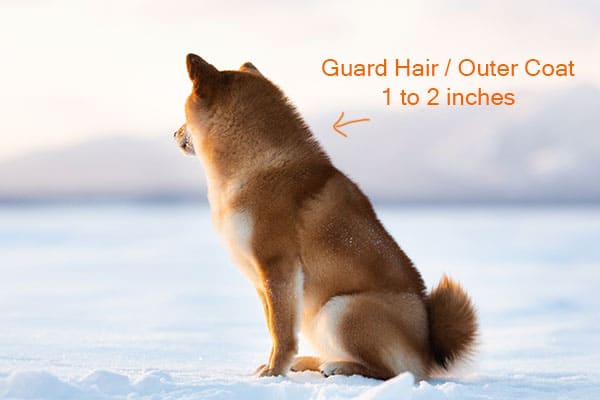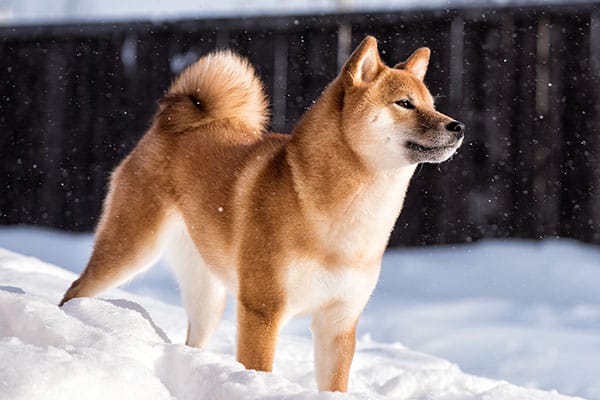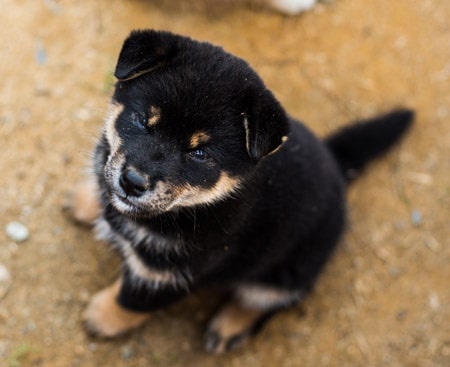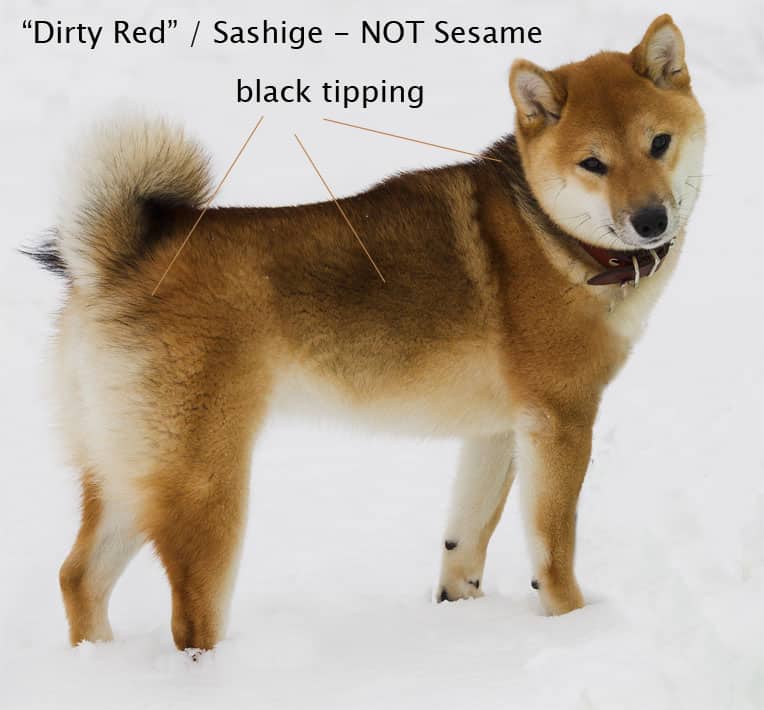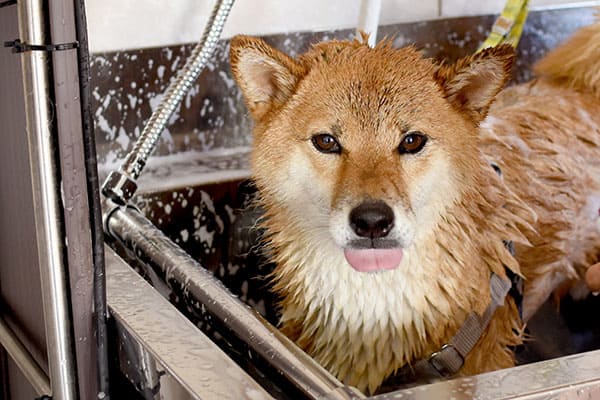BACK IN STOCK…
Karakusa Bandanas
A Shiba Inu’s coat is one of the breeds’ most magnificent asset.
A proper Shiba Inu coat lends a hand in giving Shiba Inus their unique and regal looks.
The bright “fox” red coat of Red Shiba Inus is both the most beautiful and popular coat of the three standard coat colors.
The nuanced balance of deep reds melding with creamy-white urajiro markings is both understated and striking at the same time.
The black and tan Shiba has a gorgeous and deep rusty black coat speckled with adorable tan points on the face, chest, and legs.
Black and tans are known for their impishly cute looks and are sometimes mistaken for huskies.
The most mysteriously captivating of the three coats is the sesame coat.
A sesame’s magnificent wolf-like coat is both rare and intriguing.
For Shiba Inu enthusiasts, finally setting eyes on a true sesame is an exhilarating treat.
Shiba Inus are a double coated dog breed – the outer coat being stiff and straight, and the undercoat being plush and thick.
Double coated dog breeds shed continuously throughout the year.
Twice a year, the shedding, (coat blowing) becomes heavy – usually during spring and fall.
Shiba Inu Outer Coat –
In breed standards, the outer coat, also called guard hairs, of Shiba Inus is vibrantly colored, straight and stiff.
In the show ring, a Shiba Inu’s coat texture is important.
The guard hairs should be rigid and not have any softness.
The length of the coat should be about two inches over the withers.
- On the Shiba Inu’s body, the guard hairs stand a bit off the body.
- On the Shiba Inu’s face and legs, the coat should be short, even and full.
- The Shiba Inu’s tail hair is slightly longer and stands up a bit over the tail.
Shiba Inu Under Coat –
The undercoat is soft, plush and thick.
Red Shiba Inus have light colored undercoats while Sesame and Black and tan shiba Inus have darker greyish-brown undercoats.
Sashige or dirty red Shiba Inus carrying a recessive black and tan gene will typically have dark undercoats like black and tans.
Undercoat keeps Shiba Inu insulated and warm
The Purpose of a Double Coat
The two layers of coats on your Shiba Inu have two important functions.
The dense undercoat acts as an insulator to keep the dog warm in the winter and cool in the summer.
The outer coat acts as a type of “jacket” and repels both moisture and dirt.
It also helps to protect your dog’s skin from sunburn and pesky insects.
Because Shiba Inu coats have both the function of insulating a Shiba Inu as well as protecting their skin from sunburn and pests – Shiba Inu coats SHOULD NEVER BE SHAVED.
Shiba Inu Urajiro
The distinct white markings on Shiba Inu coats is called urajiro, and is an important element of a Shiba Inu’s coat.
The loose but accurate definition of urajiro translated from Japanese means “undersurface white”.
The color tone of urajiro ranges from white to slightly off-white.
Many animal species (birds, fish, reptiles) also have these types of markings, or countermarkings (camouflage) since prehistoric times.
The dark on top and light on bottom camouflage markings helps animals to blend into their natural surroundings.
All Shiba Inus must show proper urajiro distribution to conform to breed standards. Reds have the most urajiro coverage out of the three standard coat colors.
On a Shiba Inu’s face, the urajiro must be present on the side and bottom of mouth, on the cheeks and inside the ears.
Light colored dots are permitted above the eyes on all colors but are mandatory for black and tans.
Urajiro must also be seen on the neck, chest, forechest, ventral side of tail, and on the inside area of the legs.
The transition of color gradation from urajiro to coat color should be gradual and “soft” – especially for red Shiba Inus.
Black and Tan Shiba Inus often have urajiro that resembles two triangles on the chest that resembles a bowtie at times.
While DNA testing can check for traits such as the long-haired gene – there’s no definitive genetic test for assuring proper urajiro.
However, it has been observed that Shiba Inus carrying the cream gene will display brighter urajiro covering more coat area than non cream gene carrying Shibas.
Non Standard Variations of Shiba Inu Coat types
Non standard coat types occur in most dog breeds due to genes and poor breeding practices. (no genetically testing parents, etc.)
These variations don’t conform to breed standards, so they can’t be show dogs and shouldn’t be bred.
Of course they can be loved just as much as their “standard” coat Shiba Inu brothers and sisters.
The Long Haired Shiba Inu
Long haired Shiba Inus have longer guard hairs (3 inches or more) and have a fluffy, “teddy bear” look.
Long haired Shibas are not very common but not exactly a “rare” occurrence either.
Many Spitz type dogs like the Shiba Inu and Akita carry the long coat gene in their bloodlines.
Even champion Shiba Inu show dogs were carriers of the gene which is one of the reasons why the long haired Shibas are found all around the world.
Long-haired Shiba Inu puppy on left
Reputable Shiba Inu breeders do genetic testing to ensure that they don’t breed Shiba Inus with genes that will lead to the possibility of long-haired offspring.
Seeming you guys liked the woolly husky so much, maybe you’ll enjoy my woolly Shiba, Yumi! pic.twitter.com/nGsmyYMkrp
— Cute Animals (@AnimalsReddit) August 9, 2016
[tcb-script async=”” src=”https://platform.twitter.com/widgets.js” charset=”utf-8″][/tcb-script]
Long haired Shiba Inus are caused by the recessive II gene.
Normal coated Shiba Inus have the LL gene.
Normal coated Shiba Inus who are “carriers” of the long haired gene are LI.
Some unexpecting Shiba Inu owners don’t realize they have a long haired Shiba Inu puppy until the puppy is three months or older though most knowledgeable breeders should be able to determine this by 8 weeks.
Shiba Inus with long hair who are bred from two purebred Shiba Inus are purebred but since it’s considered a major fault they aren’t allowed to be shown at dog show events.
They shouldn’t be purposely bred either.
Stay far, far away from breeders who have the galls to charge more for a long haired Shiba Inu because of their claim of their “rareness”.
You would be paying more for their “mistake” due to them not wanting to pay for genetic tests.
The “Wooly” Haired Shiba Inu
A wooly haired Shiba Inu is not quite the same as a long haired Shiba.
Instead of having a long guard hair layer, wooly Shiba Inus have less guard hairs and instead a wooly, plush, and thick coat.
Wooly Shiba Inus are also a serious fault and not allowed to show and should not be purposely.
However, wooly haired Shiba Inus are quite rare and are sure to be loved as furry and fuzzy pets.
The “Extra” Short Haired Shiba Inu
To conform to breed standards, Shiba Inu must have guard hairs between 1.5 – 2” long at the withers.
If the guard hairs are shorter than this then their undercoats must be plush enough to allow the guard hairs to stand at a 30 degree angle.
Shiba Inus that have coats with guard hairs shorter than 1.5” and lacking a plush undercoat are not considered show dog quality because they do not conform to breed standards.
Genetics and poor breeding practices account for most of the cases of “extra” short haired Shiba Inus.
Shiba Inu Coat Colors
Red Shiba Inu
The red Shiba Inu is the most popular and desired coat color. It’s also the most common coat color, comprising of 70% or more of all Shiba Inus.
The coat of red Shiba Inus should be a vibrant and pure with a candle – light orange intensity.
Clear, red coated Shiba Inus are preferred – but reds with slight black tipping on the guard hairs are permissible.
The intense orange color and urajiro of a red Shiba Inu gives it the famous fox-like appearance.
Shiba Inu puppy with clear red coat (no black tipping)
Because there is more guard hair down the spine, slight black tipping will cause that part of the coat to appear darker.
A bit of evenly scattered distributed dark hair along the back and dorsal side of the tail is permissible.
Pale and light colored red coats are not desirable.
The cause of pale Shiba Inus are sometimes due to the Shiba Inu having sparse guard hairs which allow more of the pale undercoat to show through.
Out of all the Shiba Inu coat colors, it’s harder to find the perfect red coat texture due to the tendency of their coats being softer in texture.
For more info on Red Shiba Inus, click here.
Black and Tan Shiba Inu
The Black and Tan Shiba Inu coat is tri-colored consisting of a black base coat, tan points, and urajiro.
The black should give have a rusty-brown cast due to the fact that each individual guard hair typically consists of three different hues – cream, rusty-buff, and rusty black.
Black and tan coats shouldn’t have a bluish hue.
Black and tan undercoats are gray or buff colored.
The separation of the black colored areas are clearly defined from the tan colored areas.
The tan points are located above the eyes, on the sides of the muzzle and on the outsides of the fore and hind legs down towards the toes.
Tan points is also allowed on the inside of the ears and the ventral side of the tail.
The guard hairs should stand away from the body allowing the undercoat to be seen from behind or when brushing the coat backwards.
On the face, the oval tan points above the eyebrows are about the size of thumb prints and shouldn’t be any bigger so that it causes an illusion of half moon above the eyes.
From the eyes, there should should be black separating the eyes from the white / tan mask of the cheeks and muzzle.
For more info on the Black and Tan Shiba Inu, click here.
Sesame Shiba Inu
“True” sesame Shiba Inus are quite rare.
Many Shiba Inu owners think they have a sesame when in reality they are most likely to have a sashige or “dirty red” Shiba Inu.
A true red sesame has beautiful, vibrant, red base hairs with a tipping of black points that are evenly distributed throughout the body and head.
Some true sesames with dull red base hairs have all the qualifications to be considered true red sesame but lack the desirability of a sesame that has a vibrant red base coat.
Sesame Shiba Inus are sometimes called sable Shiba Inus which is technically correct with a caveat —All sesame coats can be considered sable coats– but not all sable coats can be considered sesame coats.
Sables, on the other hand, do not have black points evenly distributed throughout their body.
Instead sables usually have a smattering of black along their backs and sides but not covering the entire torso.
Also sables don’t have usually have any black on their heads.
Sables that have areas with highly concentrated black hairs causing black saddles is undesirable.
CKK’s Sesame Team ! #shiba #Inu #shibainu #sesameshiba #gomashiba #ShibaCKK #japanesedog #dogs #kennel #elevage #柴犬 pic.twitter.com/9bPkM0dYRh
— Sabine – Shiba CKK (@ShibaCKKEduc) February 16, 2016
[tcb-script async=”” src=”https://platform.twitter.com/widgets.js” charset=”utf-8″][/tcb-script]
Sesame Shiba Inus are fairly dark but there shouldn’t have more than 50% black coverage on the coat.
These stringent coat requirements are one of the main reasons finding a “true” gorgeous red sesame is a rare but delightful treat.
Sashige / “Dirty” Red Shiba Inu
Shiba Inus with a “Sashige” or “shaded red” coat are often confused with sesame Shiba Inus – which led to them being registered as “red sesame” Shiba Inu in the past.
Sashige Shiba Inus are not sesame Shiba Inus and should be classified as reds for purposes of registration only.
A sashige Shiba Inu’s coat is red with black tipping marking some or much of the body.
This black tipping is never solid black and instead, is dispersed evenly in the areas that its located.
And the black tipping or shading is not found on the face.
This fact is one way to rule out the Shiba Inu being sesame as all sesames have black tipping on their face.
Sashige Shiba Inus usually have an off-white or creamier color urajiro markings than red Shiba Inus.
Genetically speaking, Sashige Shiba Inus often carry the black and tan (most common) or agouti gene in addition to the absence of the cream gene
Non-Standard Breed Colors
Cream Shiba Inu
Cream Shiba Inus are purebred Shiba Inus with a white / cream coat and a white undercoat.
The cream coat color is a majorly faulted coat color that does not conform to breed standards.
The urajiro or white markings on Shiba Inus are important for breed standards and cannot be distinguished on cream Shiba Inus which is why it’s a major fault.
Cream Shiba Inu are the results of a recessive pale red gene that got passed from one or both its parents.
Since a cream Shiba Inu is the result of a recessive pale red gene, cream Shiba Inu are not pure white but rather cream coated.
Red tipping on the ears is common.
Since the black gene is missing, creams do not have any black in their coat.
For reasons yet not completely understood, some cream Shiba Inus have cream coats with a hint of pale peach, yellow, or salmon colors.
In Japan, Nippo does not allow cream Shiba Inus in the show ring – but they can be registered.
In America, AKC faults cream Shiba Inus but do allow them to show.
Cream Shiba Inus should not be mistaken for other forms of “white-coated” dogs such as albino, double merle, harlequin, and extreme white piebald – all of which are associated with increased health issues.
Cream Shiba Inus are just as healthy as other Shiba Inus except when they are purposely inbred by unscrupulous breeders.
All reputable Shiba Inu breeders who breed for the love and preservation of the breed will not knowingly breed cream Shiba Inus or genetic pairs that can possibly produce a cream Shiba Inu puppy.
While genetic testing is a deep and complex subject – most tests for coat color and coat length are fairly reliable.
Read more about the cream Shiba Inu here.
Pinto / Piebald Shiba Inu
Pinto or piebald Shiba Inus have coats that appear to have flat white markings, spots, and “socks”.
The term socks relates to the white markings on the paw that can either look like short socks or longer socks.
The Pinto can have various degrees of white markings ranging from a few spots to almost fully white with darker spots (like a Holstein cow).
Pinto Shiba Inu pic.twitter.com/OJ8pyjFu6V
— ShibeGallery (@ShibeGallery) April 17, 2018
[tcb-script async=”” src=”https://platform.twitter.com/widgets.js” charset=”utf-8″][/tcb-script]
Most breeders will have some tolerance for “some” white pinto markings on the chest and paws.
However there comes a point when a Pinto becomes labeled as a serious mismark due to extensive white markings.
The Pinto is even less favored than the cream by the Japanese and has been purposely selected against – mainly for aesthetic reasons.
The Pinto is not the cause of mix breeding but rather from recessive genes just as with the cream.
Currently, genetic tests can only identify one “white spot” gene but it has been theorized that there maybe another gene responsible for white spotting.
iBecause of the complexity of genetics, breeders can use a combination of DNA testing and common sense breeding practices to have the best chance of avoiding mismarked Shiba Inus.
Unfortunately, pinto Shiba Inus are normally – but not always – a good indication that the Shiba Inu was bred from a puppy mill or backyard breeder.
Creeping Tan / Saddle Tan Shiba Inu
Video of Creeping Tan / Saddle Back Shiba Inu:
The creeping tan coat is a rare anomalous variation of the black and tan coat.
It’s also the same type of coat found on German Shepherds, Airedales, and certain hounds.
Much of the coat is “saddled” with black throughout the back and parts of chest. The face is usually all red.
This type of coat does not conform at all to breed standards and should never be bred purposely.
Missed my dogs so much #shibainu #mange pic.twitter.com/upUw4nF4Qz
— Insomniac Cactus (@cacticanine) December 12, 2015
[tcb-script async=”” src=”https://platform.twitter.com/widgets.js” charset=”utf-8″][/tcb-script]
The exact gene / genes causing this coat variation are not fully understood which makes DNA testing for this coat unreliable.
The only way a breeder can reliably avoid breeding this coat is by breeding two pure red Shibas and avoid the black and tan gene altogether.
sources: http://www.shibainuireland.com/english/genetics/index.html
https://masakadoshiba.wordpress.com/2013/12/17/coat-color-inheritance-in-shibas-cream-and-agouti/
http://www.doggenetics.co.uk/albino.html
https://www.shibas.org/newstand/coat%20color%20and%20length%20genetics.html
Shiba Inu Coat Care
To keep your Shiba Inus coat healthy and beautiful two things must be considered – their diet, and proper grooming practices.
It’s important to feed your Shiba Inu the best food possible – preferably a balanced, homemade diet rich in omega 3’s, polyphenols and quality proteins.
Also, always be sure to provide your Shiba with fresh and filtered water. Natural, not filtered municipal water is best.
Since Shiba Inus are double-coated dogs that shed, extra attention must be given to ensure that their coat stays healthy and manageable.
Frequent brushing with the right tools will help to keep the undercoat from matting while the brushing will help to distribute oil from the skin to the coat
“Blowing Coat” – Shiba Style
Shiba Inus will “blow” or shed their undercoat twice a year typically during spring and fall.
During this time the normal amount of daily Shiba Inu shedding amps up to full power.
For a weeks during this coat blowing season be sure to groom your Shiba Inu regularly to prevent undercoat matting.
The extra grooming will also prevent excessive fur in your living areas, clothes, and yes, food.
Bathing should be done on a semi-regular basis, especially if the Shiba Inu suffers from any allergy issues.
The same oils that are beneficial for your Shiba’s coat eventually accumulate (due to low evaporation rates) to the point of clogging up the pores in the skin.
This trapped oil also traps debris and bacteria which eventually leads to the dreaded “smelly dog” odor.
So basically, bathing is necessary to keep your Shiba Inu’s coat hygienic and free from debris, “old” skin oil, and other “gunk” that can accumulate on coats.
It’s 2021 – don’t believe the myth that bathing is harmful to a dog’s coat.
It’s almost been a century when this myth was indeed reality when pet soaps where made out of harsh, caustic chemicals such as lye.
There is such a wide selection of high quality, organic shampoos and conditioners that work to improve and protect both the coat of skin of your Shiba Inu.
Shiba Inu Coat Problems
Brittle / Dull Coat –
Shiba Inu with dull or brittle coats could be suffering from a number of different health issues which include:
- Hormonal Imbalance
- Thyroid Issues
- Cushings Syndrome
- Diabetes
- Parasitic infestation
- Cancer
Sometimes a poor diet lacking proper nutrition and omega-3 oils can also contribute to the dulling of coats.
Even though certain commercial dog foods include omega-3 oils in their foods, much of the value is lost due to the high heat processing which makes the omega-3’s largely bio “un” available.
If the dulling is moderate to severe, than it’s best to see a vet as soon as possible. For more info on dull coats, read here.
Hair Loss / Alopecia
Having a Shiba Inu with hair loss whether mild, moderate, or severe is an disheartening and worrisome experience.
Hair loss can be caused by a wide range of culprits such as allergies (especially F.A.D. in Shiba Inus), mange, folliculitis, hormonal / immune / endocrine issues and infections.
Diagnosing the exact cause of the hair loss should be done by a veterinarian as soon as possible so treatment protocols can be prescribed.
Learn more about dog hair loss here.
Excessive Shedding
During coat blowing seasons, Shiba Inus will lose a lot of fur which is normal.
However, when Shibas lose so much fur that bald spots appear, their could be an underlying issue causing the excessive hair loss.
As with normal hair loss, hair loss from excessive shedding can be caused by a number of issues including:
- Self-induced hair loss due to excessive licking
- Diet
- Immune problems
- Medications
- Pregnancy / hormonal imbalance
- Kidney, liver, thyroid disease
- Adrenal disease (Cushings)
- Parasites (Fleas / ticks)
- Allergies
- Fungal / bacterial infections
- Environmental (shampoo, pesticides)
With so many possible causes of hair loss, it’s best to consult your veterinarian early on to develop a proper treatment plan.
Other Skin Issues That Affect Coat Appearance
Hot Spots
Hot spots or acute moist dermatitis is a common skin problem caused by excessive scratching and licking in the one “hot spot” area.
Hot spots are caused by a number of issues which many are the same culprits causing hair loss.
Hot spots are not contagious or a serious issue in it and by itself, however the underlying cause of the hot spots could be.
Only your veterinarian can properly diagnose the underlying cause and prescribe a treatment plan.
The use of an Elizabethan-style collar is very helpful in preventing your dog from excessive licking and biting.
Read more about hot spots here.
Seborrhea
Canine seborrhea is common skin condition in dogs characterized by flaky skin (dandruff) as well as oily skin and hair.
The accumulation of excess oils leads to a clogging of skin pores causing an unpleasant odor.
The cause of canine seborrhea is either inherited or caused by a secondary disease such as diet, allergies, parasites, endocrine and immune disorders.
Idiopathic seborrhea is not treatable but can be managed.
Diet and supplementation plays a big role in managing seborrhea.
Consult with your veterinarian to receive a proper diagnosis and treatment plan.
Mange
Mange is a highly contagious skin disease caused by exposure to the Sarcoptes mite from other infected animals.
Mange is a serious issue that can be transmitted to humans and other animals.
Veterinary care and in some cases, quarantine is warranted immediately.
Treatment time takes roughly 4- 6 weeks and includes a rigorous bathing schedule with scabicidal dips such as invermectin.
Certain cases will also call for oral medications. Learn more about Mange here.
Folliculitis
Folliculitis, often referred to as bacterial folliculitis, is one of the most common canine skin infection.
Folliculitis develops when healthy hair follicles become infected with a bacteria that is normally found on the animal’s skin.
Usually, this bacteria does not cause any issues. However, when hair follicles become irritated or damaged due to scratching, trauma, or an underlying disease – bacteria sets in and results in an infection.
Underlying diseases such as thyroid diseases and auto immune diseases can be the source of folliculitis.
Other skin problems like allergies, canine acne, and parasitic / fungal issues can lead to folliculitis.
Folliculitis is characterized by red, itchy skin that can experience hair loss, swelling, color changes and pain.
Folliculitis can be treated with a combination of oral medication, topical medication, and addressing the underlying cause.
Some Shiba Inus are prone to F.A.D. or flea allergy dermatitis. Be sure to always have Shiba Inus with F.A.D. on an effective flea elimination protocol.
Excessive scratching due to F.A.D. can easily lead to folliculitis.
Learn more about folliculitis here.
Ringworm
Ringworm is a highly contagious skin disease that is actually caused by a fungus.
Although ringworm is not an acutely serious skin disease – it is a disease that can spread to other animals as well as humans.
If you’ve ever had or heard about “Athlete’s Foot” – that’s the same fungus as ringworm.
Symptoms of ringworm include circular areas of hair loss, inflamed skin, scabs, and dry / brittle hair. Ringworm does not usually cause much itching.
Young, old, and immuno-compromised dogs often are more prone to ringworm disease.
Ringworms are treatable with a combination of oral drugs and topical medication.
It’s also critical to thoroughly clean and disinfect all of the areas that your dog inhabits.
Learn more about ringworm in dogs here.
Thanks for visiting Myfirstshiba.com! We do our very best in providing our readers with awesome content about our beloved Shiba Inu breed. Some of our articles include reviews and recommendations to our favorite products. We do occasionally earn commissions from certain affiliate links that help support our work and mission. Thanks again for visiting. Shiba Kisses To All!
